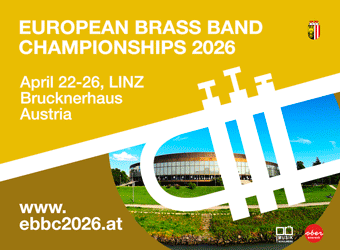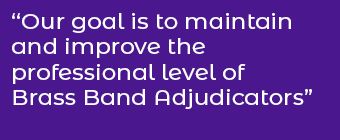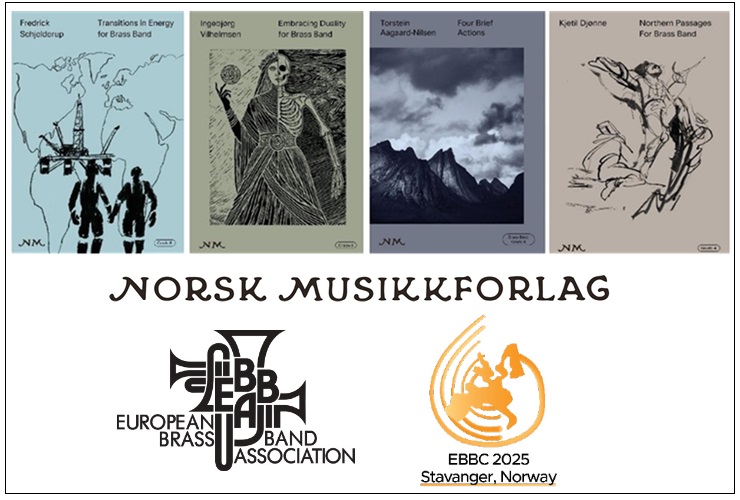
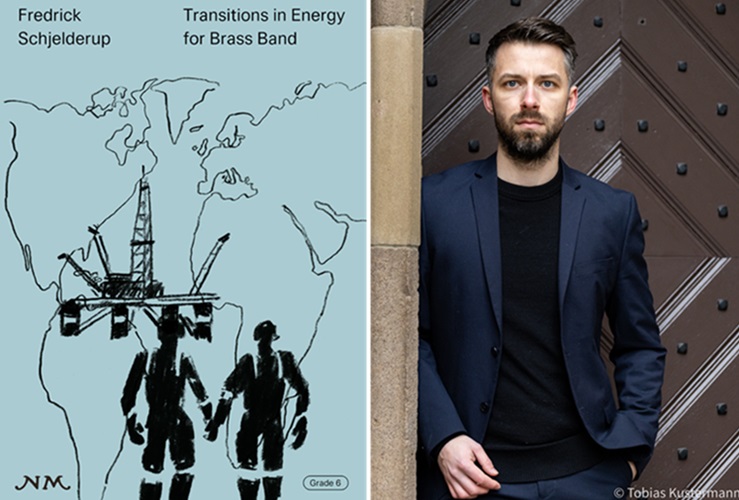
Championship Section:
Transitions in Energy (Fredrick Schjelderup)
Commissioned by the Norwegian Band Federation (NMF) in collaboration with the European Brass Band Association (EBBA), 'Transitions in Energy' has been developed from an original concept by Olav M. Skar, a well-known brass band supporter and a leading figure in health and safety security in the oil industry.
From it, composer Fredrick Schjelderup reflects on how the production of this primary source of Norwegian energy and financial prosperity has impacted on the nation’s environment and society, as well as the challenges it brings for future generations.
The ‘transition’ of the title refers to how the natural resource was created and then exploited, with its inherent dangers at times taken for granted, resulting in tragic outcomes. The final section embraces the optimism that now comes with the communal drive towards a greener, cleaner future.
Past, Present, Future
Written in three continuous movements — The Past, The Present and The Future, the central section is a ‘Memoriam' tribute to the 123 lives lost in the Alexander L. Kielland disaster on the 27th March 1980. It remains the worst disaster in Norwegian waters since the Second World War. A memorial to those lost was erected in Stavanger in 1986 entitled, ‘Broken Chain’.
‘The Present’ is driven by human interaction and desire to exploit its energy sources. The music reflects the new leviathans of the sea created to drill deep into the earth’s surface, the possibilities of technology seemingly endless, and so too the new prosperity it brings.
The thematic basis of the work comes from a central ‘Gaia’ motif which eventually emerges from the opening.
Here the music portrays ‘The Past’ – a primordial nothingness as the mysterious forces of immense energy emerge to create the earth amid the explosion of the ‘Big Bang’, and from which arises the beauty of an unspoilt world.
‘The Present’ is driven by human interaction and desire to exploit its energy sources. The music reflects the new leviathans of the sea created to drill deep into the earth’s surface, the possibilities of technology seemingly endless, and so too the new prosperity it brings.
Human lives
However, the darker side of rapacious exploitation brings danger – one that comes at the cost of human lives.
The central ‘Interlude’ is described as, “an ode to the victims of the Alexander L Kielland accident” – one that arose from improper work undertaken on the oil rig in its initial construction and lax safety evacuation procedures.
The central ‘Interlude’ is described as, “an ode to the victims of the Alexander L Kielland accident” – one that arose from improper work undertaken on the oil rig in its initial construction and lax safety evacuation procedures. The composer paints an evocative canvas, “of an empty sea, where life should have prevailed and where waves signify the calls of survivors who pay homage to those lost”.
The final section ‘The Future’ is written with uplifting verve as the music draws the listener “into our future with an optimistic perspective” – the newly energised environment changed for the good of us all by repurposed technological ingenuity.
Composer:
Fredrick Schjelderup (b. 1990) is a composer, arranger and conductor from Bergen.
A percussionist, he finished his bachelor’s degree in composing at Grieg Academy of Music (University of Bergen) in 2014, and has since become a successful award-winning composer for the brass band medium. He works have bene performed extensively across the world in major championship events.
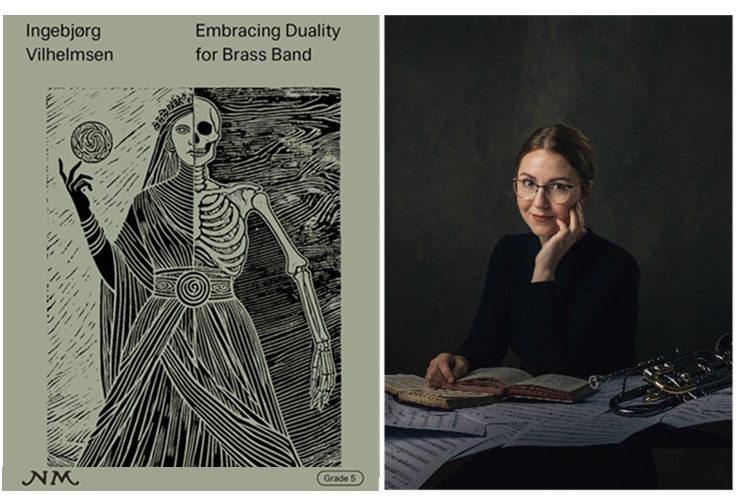
Challenge Section:
Embracing Duality (Ingebjorg Vilhelmsen)
This new 10-minute work by the 2024 4BR 'Newcomer of the Year' award winning composer Ingebjorg Vilhelmsen is inspired by Norse mythology and the figure of Hel, the ruler of the underworld.
A complex figure reflecting on the cyclical nature of life and death, Hel represents the idea that death is not to be feared but instead should be accepted as a natural part of existence, with her realm, Helheim, serving as a place of rest and judgement for departed souls.
Life and death
Hel is often depicted as having a dual appearance; one half of her body of a living woman, while the other half that of a corpse — symbolising her dominion over both life and death.
Hel is often depicted as having a dual appearance; one half of her body of a living woman, while the other half that of a corpse — symbolising her dominion over both life and death.
The opening ‘Balanced Judgement’ reflects a fair and impartial judge of the souls who enter her realm. She decides the fate of each based on their deeds in life – contrasting thematic arguments holding the central attention.
Good nor evil
‘Cosmic Balance’ that follows reveals that she herself is neither entirely good nor entirely evil, embodying the idea that life and death are interconnected and that both are necessary aspects of existence – the music again contrasting but with a very different feel.
‘Ruler of Helheim’ sets out the central landscape of the work - where souls of the deceased reside after death – cold and bleak. The contrast with the glory of Valhalla for those chosen to reside there is acutely heard.
Finally, ‘Symbol of Mortality’ and Hel’s own appearance as half-living and half-dead serves as a stark reminder of the impermanence of life and the inevitability of death – dark, dramatic and powerfully magnetic as it draws the ensemble and the listener to its close.
Composer:
Ingebjørg Vilhelmsen is a Norwegian composer, orchestrator, arranger, and cornet player.
She specializes in test pieces and other major works for brass band, concert band, and orchestra. Her compositions have been performed at various national and international competitions, concerts, festivals and workshops.
Ingebjørg has a master’s degree in Musicology from the University of Oslo, focusing on composition of contest music for brass band. She also studied music at Goldsmiths (University of London), as well as extra credits in composition at the Norwegian Academy of Music.
European Youth Championships:
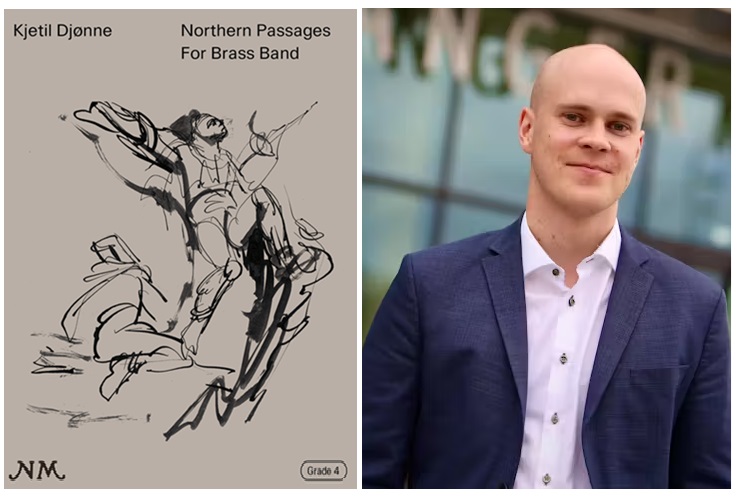
Premier Section:
Northern Passages (Kjetil Djonne)
This four-movement work portrays the Norwegian landscape through traditional dance music.
The first movement paints a picture of fjords and mountains, whilst the second is a playful mazurka inspired by the musical 'Smatroll' of Johan Halvorsen and Edvard Grieg.
The Hardanger fiddle is the inspiration to the third movement, 'Bansull', with the fourth a traditional song from the Norwegian dance hall.
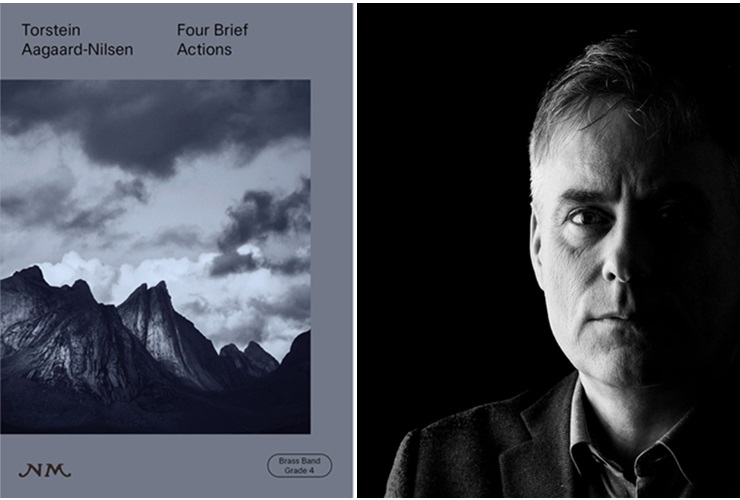
Development Section:
Four Brief Actions (Torstein Aagaard-Nilsen)
The work has no storyline narrative, but each movement is self-explanatory. The opening 'Chasing' is a canon made up of short motifs as in a chase towards its conclusion.
The second, 'Running' is a funky semiquaver race, whilst the third, 'Singing' is made up of melodic fragments and small melodies played in cantabile style.
The ending is inspired by an old Viking song 'Sigurd Favnesbane' (Sigurd the Dragons Slayer) to bring the work to a rousing conclusion.



